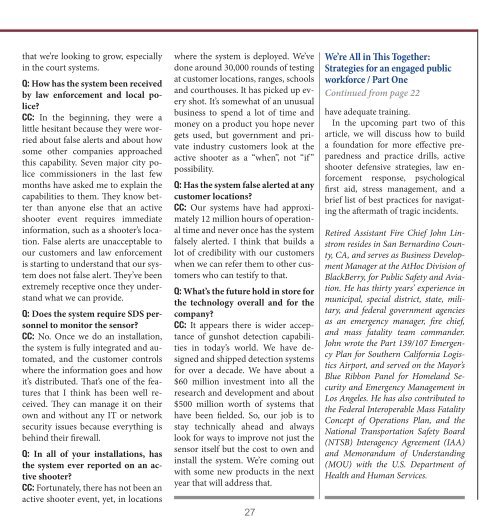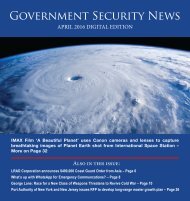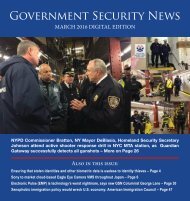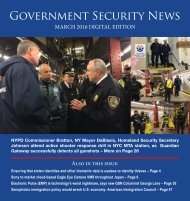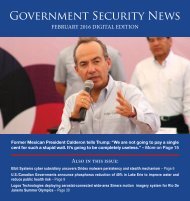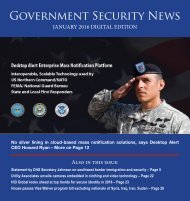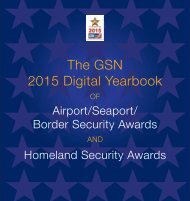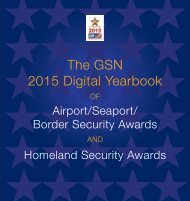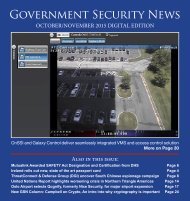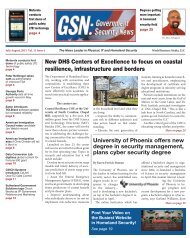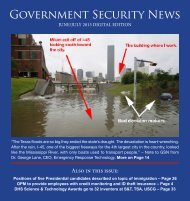GSN March 2016 Digital Edition
You also want an ePaper? Increase the reach of your titles
YUMPU automatically turns print PDFs into web optimized ePapers that Google loves.
that we’re looking to grow, especially<br />
in the court systems.<br />
Q: How has the system been received<br />
by law enforcement and local police?<br />
CC: In the beginning, they were a<br />
little hesitant because they were worried<br />
about false alerts and about how<br />
some other companies approached<br />
this capability. Seven major city police<br />
commissioners in the last few<br />
months have asked me to explain the<br />
capabilities to them. They know better<br />
than anyone else that an active<br />
shooter event requires immediate<br />
information, such as a shooter’s location.<br />
False alerts are unacceptable to<br />
our customers and law enforcement<br />
is starting to understand that our system<br />
does not false alert. They’ve been<br />
extremely receptive once they understand<br />
what we can provide.<br />
Q: Does the system require SDS personnel<br />
to monitor the sensor?<br />
CC: No. Once we do an installation,<br />
the system is fully integrated and automated,<br />
and the customer controls<br />
where the information goes and how<br />
it’s distributed. That’s one of the features<br />
that I think has been well received.<br />
They can manage it on their<br />
own and without any IT or network<br />
security issues because everything is<br />
behind their firewall.<br />
Q: In all of your installations, has<br />
the system ever reported on an active<br />
shooter?<br />
CC: Fortunately, there has not been an<br />
active shooter event, yet, in locations<br />
where the system is deployed. We’ve<br />
done around 30,000 rounds of testing<br />
at customer locations, ranges, schools<br />
and courthouses. It has picked up every<br />
shot. It’s somewhat of an unusual<br />
business to spend a lot of time and<br />
money on a product you hope never<br />
gets used, but government and private<br />
industry customers look at the<br />
active shooter as a “when”, not “if ”<br />
possibility.<br />
Q: Has the system false alerted at any<br />
customer locations?<br />
CC: Our systems have had approximately<br />
12 million hours of operational<br />
time and never once has the system<br />
falsely alerted. I think that builds a<br />
lot of credibility with our customers<br />
when we can refer them to other customers<br />
who can testify to that.<br />
Q: What’s the future hold in store for<br />
the technology overall and for the<br />
company?<br />
CC: It appears there is wider acceptance<br />
of gunshot detection capabilities<br />
in today’s world. We have designed<br />
and shipped detection systems<br />
for over a decade. We have about a<br />
$60 million investment into all the<br />
research and development and about<br />
$500 million worth of systems that<br />
have been fielded. So, our job is to<br />
stay technically ahead and always<br />
look for ways to improve not just the<br />
sensor itself but the cost to own and<br />
install the system. We’re coming out<br />
with some new products in the next<br />
year that will address that.<br />
27<br />
We’re All in This Together:<br />
Strategies for an engaged public<br />
workforce / Part One<br />
Continued from page 22<br />
have adequate training.<br />
In the upcoming part two of this<br />
article, we will discuss how to build<br />
a foundation for more effective preparedness<br />
and practice drills, active<br />
shooter defensive strategies, law enforcement<br />
response, psychological<br />
first aid, stress management, and a<br />
brief list of best practices for navigating<br />
the aftermath of tragic incidents.<br />
Retired Assistant Fire Chief John Linstrom<br />
resides in San Bernardino County,<br />
CA, and serves as Business Development<br />
Manager at the AtHoc Division of<br />
BlackBerry, for Public Safety and Aviation.<br />
He has thirty years’ experience in<br />
municipal, special district, state, military,<br />
and federal government agencies<br />
as an emergency manager, fire chief,<br />
and mass fatality team commander.<br />
John wrote the Part 139/107 Emergency<br />
Plan for Southern California Logistics<br />
Airport, and served on the Mayor’s<br />
Blue Ribbon Panel for Homeland Security<br />
and Emergency Management in<br />
Los Angeles. He has also contributed to<br />
the Federal Interoperable Mass Fatality<br />
Concept of Operations Plan, and the<br />
National Transportation Safety Board<br />
(NTSB) Interagency Agreement (IAA)<br />
and Memorandum of Understanding<br />
(MOU) with the U.S. Department of<br />
Health and Human Services.


